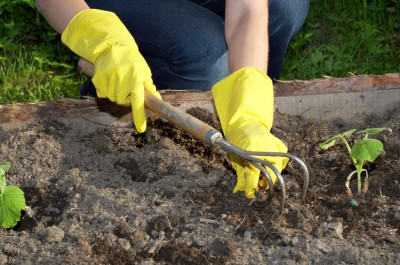|
Listen To The Article
|
 Biointensive gardening is a sustainable food production method formulated by Alan Chadwick. It is not his invention by any means; similar systems have been in use in several agricultural communities from time immemorial, but he adapted it to modern times and needs, drawing heavily on the biodynamic methods and the intensive French gardening practices. He introduced this organic gardening system to America as an alternative to conventional farming practices that deplete soil fertility. John Jeavons of Ecology Action further developed into a replicable system of agriculture that made it popular in several countries world over.
Biointensive gardening is a sustainable food production method formulated by Alan Chadwick. It is not his invention by any means; similar systems have been in use in several agricultural communities from time immemorial, but he adapted it to modern times and needs, drawing heavily on the biodynamic methods and the intensive French gardening practices. He introduced this organic gardening system to America as an alternative to conventional farming practices that deplete soil fertility. John Jeavons of Ecology Action further developed into a replicable system of agriculture that made it popular in several countries world over.
Biointensive gardening is a practical method of gardening ideal for small plots. This scientific method works on the principles of sustainability and maximum yield from minimum area. Enriching the soil, and continuously amending with organic inputs to increase fertility naturally is the most important feature. Plants are grown close together and beneficial insects are encouraged to take up residence in the garden to increase biodiversity and to keep pest populations under control. The crops are selected carefully for their capacity to produce maximum yield by way of food as well as the biomass they produce that can be plowed back into the system.
How You Can Practice Biointensive Gardening
Anyone with a piece of land anywhere in the world can successfully replicate this system by following its 8 major principles. It enables people to produce twice or even thrice the amount of food from the given area compared to conventional agriculture.
New Survival Seed Bank™ Lets You Plant A Full Acre Crisis Garden!
At the same time, the health and fertility of top soil in the area is increased manifold. According to Jake Blehm, assistant executive director at Ecology Action, preparing the soil is the first, as well as most important, step in the process.
- Deep soil preparation. Biointensive farming is done in raised beds that have been double dug up to a depth of two feet to increase aeration. It is a prerequisite to increasing soil fertility through the action of soil microbes. Soil is viewed as a living, breathing organism. Loose top soil contains the maximum number of microorganisms and facilitates faster root growth. The water-retaining capacity of the soil is increased, while loss through evaporation is minimized.
- Composting. To further improve the structure of the top soil and increase its fertility, compost is liberally added. Compost is decayed organic matter; hence it is rich in carbon. It contributes to the healthy growth of crops. Sixty percent of the green matter produced during the growth of the crops is plowed back into soil, repeating the cycle. It can be considered a form of carbon sequestration as carbon dioxide from the atmosphere gets locked into plant tissues and goes into the soil as compost. Soil with high humus content needs less water, which means a big saving on this essential commodity.
- Intensive planting. The seedlings are planted close together in such a way that when fully grown, their leaves touch, forming a green carpet over the soil. This provides an ideal environment for microbial growth in the soil while reducing loss of water from the topsoil by evaporation. Close plantings ensure more food production per square foot, too.
- Companion planting. It is an age old practice that makes optimum use of water, light and nutrition. The companions work together for mutual benefit. Growing the aquatic fern azolla in paddy fields discourage weed growth while facilitating nitrogen fixation. The combination of corn, squash, and beans is known as the ‘three sisters’. Companion plants are selected carefully to complement one another as they grow together. Marigold is co-planted with vegetables to reduce pest problems. Legumes help fix atmospheric nitrogen in the soil, making it available to plants.
- Carbon farming. Plants employed in biointensive farming are selected for the high biomass they produce. They go back to the soil as compost to enrich it. This is termed as carbon farming. Preservation of soil fertility and non-dependence on chemical fertilizers are the major advantages.
- Calorie farming. Food production for the farmer is measured by the calorie value of the food items produced. Plants that produce more calories per square feet are deployed in a larger area while essential items with less calorific value are restricted to 10 percent of total area. Sixty percent of the cultivated area is used to grow cereals, while 30 percent is set aside for root crops.
- Use of open-pollinated seeds. Flowers freely cross pollinated by insects and by other means are preferred as they encourage genetic diversity. Instead of buying expensive, patented seeds every time, farmers are encouraged to make their own seeds for subsequent crops.
- Whole system method. Biointensive gardening is promoted as a whole system to ensure maximum food production from a given area, while enhancing the quality of the soil, too.
There are many benefits of biointensive farming, such as:
- Significant reduction in water requirement.
- Non-dependence on chemical fertilizers.
- Energy efficient food production.
- Doubling and tripling of food production.
- Production of healthy, highly nutritious food.
- Building healthy soil.
- Potential to reduce land under cultivation.
- Prevention of desertification.
On a small scale, biointensive agriculture can ensure local production and consumption of food, reducing food miles. If widely practiced, it can reduce the total amount of land required for agricultural use by half, freeing up the rest of the area for natural vegetation.
Sign up for Off The Grid News’ weekly email and stay informed about the issues important to you
 Off The Grid News Better Ideas For Off The Grid Living
Off The Grid News Better Ideas For Off The Grid Living




